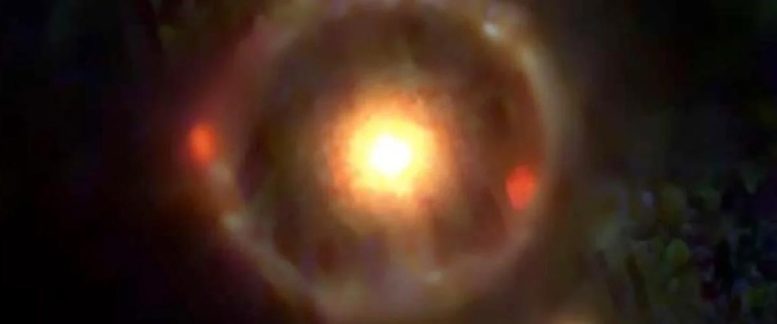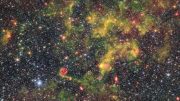
JWST discovered the ancient galaxy JWST-ER1g, featuring a unique Einstein ring that aids in studying the galaxy’s high dark matter density and testing dark matter properties. Credit: Van Dokkum et al. 2023
The James Webb Space Telescope discovered an ancient galaxy, JWST-ER1g, which exhibits a phenomenon called strong gravitational lensing, forming an Einstein ring. This galaxy, rich in dark matter, provides new insights into dark matter’s properties and density.
Last September, the James Webb Space Telescope, or JWST, discovered JWST-ER1g, a massive ancient galaxy that formed when the universe was just a quarter of its current age. Surprisingly, an Einstein ring is associated with this galaxy. That’s because JWST-ER1g acts as a lens and bends light from a distant source, which then appears as a ring — a phenomenon called strong gravitational lensing, predicted in Einstein’s theory of general relativity.
Analyzing Dark Matter
The total mass enclosed within the ring has two components: stellar and dark matter components.
“If we subtract the stellar mass from the total mass, we get the dark matter mass within the ring,” said Hai-Bo Yu, a professor of physics and astronomy at the University of California, Riverside, whose team has published new work about JWST-ER1g in the journal The Astrophysical Journal Letters. “But the value for the dark matter mass seems higher than expected. This is puzzling. In our paper, we offer an explanation.”
The Dark Matter Halo
A dark matter halo is the halo of invisible matter that permeates and surrounds a galaxy like JWST-ER1g. Although dark matter has never been detected in laboratories, physicists are confident dark matter, which makes up 85% of the universe’s matter, exists.
“When ordinary matter — pristine gas and stars — collapses and condenses into the dark matter halo of JWST-ER1g, it may be compressing the halo, leading to a high density,” said Demao Kong, a second-year graduate student at UCR, who led the analysis. “Our numerical studies show that this mechanism can explain the high dark matter density of JWST-ER1g — more dark matter mass in the same volume, resulting in higher density.”
Unique Lensing Features and Research Opportunities
According to Daneng Yang, a postdoctoral researcher at UCR and co-author on the paper, JWST-ER1g, formed 3.4 billion years after the Big Bang, provides “a great chance to learn about dark matter.”
“This strong lensing object is unique because it has a perfect Einstein ring, from which we can obtain valuable information about the total mass within the ring, a critical step for testing dark matter properties,” he said.
Contributions of the James Webb Space Telescope
Launched on Christmas Day in 2021, NASA’s JWST is an orbiting infrared observatory. Also called Webb, it is designed to answer questions about the universe. It is the largest, most complex, and powerful space telescope ever built.
“JWST provides an unprecedented opportunity for us to observe ancient galaxies formed when the universe was young,” Yu said. “We expect to see more surprises from JWST and learn more about dark matter soon.”
The title of the open access research paper is “Cold Dark Matter and Self-interacting Dark Matter Interpretations of the Strong Gravitational Lensing Object JWST-ER1.”
Reference: “Cold Dark Matter and Self-interacting Dark Matter Interpretations of the Strong Gravitational Lensing Object JWST-ER1” by Demao Kong, Daneng Yang and Hai-Bo Yu, 11 April 2024, The Astrophysical Journal Letters.
DOI: 10.3847/2041-8213/ad394b
The study was supported by the John Templeton Foundation and the U.S. Department of Energy.










What happens if the data does not verify the existence of dark energy or dark matter?
Space by it’s nature has inherent energy, as in vacuum energy, which allows subatomic particles to phase in and out of our space time. This infers that it has energetic “qualities” immediately adjacent to and interactive with our own
baryonic+leptonic universe.
In all physically observed instances wave energy requires a transport medium in order to propagate the energy from point to point in oscillatory fashion. The overall wave energy decreases as it becomes attenuated over the distance travelled through the medium. It seems reasonable to expect that EM and gravity waves must have some
form of energetic medium that provides a synergistic transport for wave energy to traverse the vast distances of our universe. If this concept is correct, then there must be an analog to the inverse square law that accommodates the loss of energy or red shift of EM waves that is observed over vast cosmic distances. If this is the case, then perhaps this explains the Doppler shift paradox and reopens the concept of the luminiferous aether which could actually be a different dimension beyond our own that supports the wave function formulas and allows energy transfer through
the vacuum of space. This would likely be the conceptual “Dark Energy” theory that has been so difficult to observe and quantify. It is just anther name for the “luminiferous aether” theory. This might also create conditions whereby large galactic gravitational fields attract the subatomic matter contained in the adjacent spacial dimension, which collectively contributes to, and synergetically enhances, the total gravitational forces
of the entire dimensional space being gravitationally influenced.
Oh, dark matter, the cosmic clown that’s had astronomers chuckling for a century, and there’s still no sign of a punchline that makes sense. It’s like they’ve been on an intergalactic wild goose chase for a hundred years, and all they’ve got to show for it is a bunch of cosmic whoopee cushions that keep deflating when they sit on them.
Now, enter axions, the absurdity’s absurdity. Astronomers, in their never-ending quest to turn the universe into a comedy show, have introduced these quirky particles into the cosmic script. It’s as if they’ve decided to juggle flaming bowling pins while riding a unicycle on a tightrope that’s on fire – you know, just to make the whole thing even more ridiculous.
Picture this: Astronomers, with telescopes pointed at the void, staring blankly at the cosmic canvas, suddenly shout, “Dark matter, axions, and…um, other stuff, I guess?” as if they’re naming random things from their grocery list and hoping it will magically make sense. It’s like trying to play chess with a set of Scrabble tiles – chaotic and utterly incoherent.
They’ve essentially turned the pursuit of knowledge into a century-long cosmic slapstick routine, where the punchline is eternally delayed, and dark matter is the banana peel that keeps astronomers slipping. Axions, in this carnival of chaos, are the cotton candy that’s been flung into the crowd, sticking to everyone and making everything even stickier.
So, here’s to our persistent astronomers, who’ve transformed the cosmos into a never-ending cosmic stand-up show, with dark matter as the bumbling, pratfall-prone comedian. Keep the popcorn handy, folks; this spectacle of cosmic confusion shows no sign of a sensible ending anytime soon.